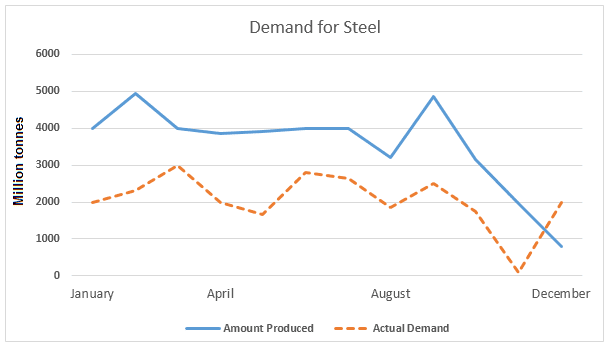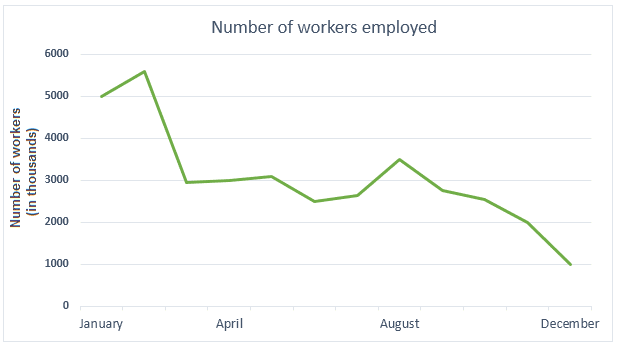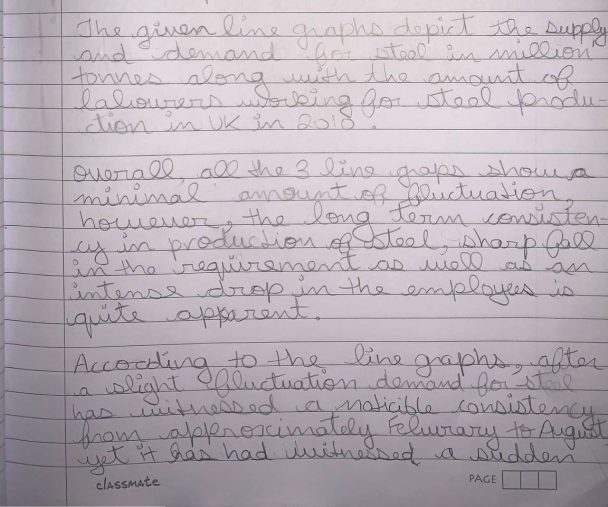-
Academic Task-1 ( Line graph)
Posted by Falak on August 18, 2021 at 6:55 PMThe line graphs below show the production and demand for steel in million tonnes and the number of workers employed in the steel industry in the UK in 2010.
Summarize the information by selecting and reporting the main features, and make comparisons where relevant.
AGAPE replied 1 year, 10 months ago 15 Members · 26 Replies -
26 Replies
-
The line graphs illustrate the production and demand for steel in million tonnes and the number of workers employed in the steel industry in the UK in 2010.
Demand for steel in January was 2000 million tonnes whereas, the amount produced was twice the number. A rise is seen in demand and production of steel by 1000 million tonnes in April. Although the demand for steel has fluctuating outcomes such as incline between April and August, a drop in August, the amount of steel produced remained steady and then declined in August. After a spike in the months between August and December by roughly 1000 million tonnes in demand and 2000 million tonnes of production, a dramatic drop is seen in the amount of steel produced from 5000 million tonnes to 1000 million tonnes. A slight drop in demand for steel is also seen from 2500 million tonnes to 0 million tonnes by September. But it exceeds to 2000 million tonnes by December.
On the other hand, the number of workers employed remains as high as 5000 to as low as 1000 in January and December respectively. Between January to December, a sharp fall of workers is seen in March(nearly) from 5500 to 3000 and remained saturated throughout April. From April to August a fluctuation can be seen in the number and by August the number of workers employed reached nearly 3500. By December, a recession is seen from 3500 to 1000 workers employed which was the lowest in the year.
-
The line graphs depict the production and demand for steel in million tonnes and the number of workers employed in the steel industry in the UK in 2010 from January to December.
Overall, both demand and production were declined at the end of the year and employment rate of number of workers was sharply fall in April.
Looking in details, production of steel in January was 4000 million tonnes whereas demand was only 2000 miilion tonnes. Production was a high increase in prodction in one month and reached to 5000 million tonnes. after that there was a fall in production and back to 4000 million tonnes in March which remained steady till July. Moreover, tremendous decline was observed from September to December which was 5000 to 1000 million tones respectively. Whereas demand was fluactating thoughout the year which was 2000 to 3000 million tonnes except the month of November where demand became zero.
On the otherhand, number of workers employed in the month of January were 5000 which were slightly increased in February and after that there was sharp fall to 3000 till march. this number reamined static till May and again a bit upward and downward trends were observed and reached almost 3500 in august. Employees were decresed gradually and fell down to 1000 in December.
-
Feedback :
both demand and production were declined at the end of the year (demand was not dropped at the end of the year rather caught the same amount as it was in the very beginning)
sharply fall (fell)
. Production was a high increase in prodction in one month (Amount of production showed an increment of 1000 million tones in one month)
this (This) number reamined static (remained)
Important tip : Proof reading is must as silly mistakes have been observed.
Band : 2/3
-
-
The given line graphs illustrate the production and market of steel in million tonnes in the UK for the year 2010 and the number of labourers involved in its manufacturing in the same year.
Overall, there are marked fluctuations in the demand for steel throughout the year while its production showed both increasing and decreasing trend towards the beginning and end of the year but remained steady in between. The number of labourers involved also was fluctuating.
With regard to demand and supply of steel, both of them showed increasing trend in january with production (4000 million tonnes) starting from the double of demand( 2000 million tonnes) increased by 25% to reach 5000 million tonnes whereas, the market was increasing slowly to hit 3000 million tonnes by march. Thereafter, the production remained steady at 4000 million tonnes until end of july only to decline by a quarter during next month and to again fluctuated with a heavy drop towards the end of the year(1000 million tonnes).
While, the necessity for steel had fluctuations round the year, averaging above 2000 million tonnes suddenly dropped to nil in november only to regain demand next month.
The supply of labourers also fluctuated with increasing initially to above 5 million in january to decline sharply by March(3 million) and to further remain steady until august and thereafter declined to 1 million by the end of the year.-
The given line graphs illustrate the production and actual needs of steel in million tonnes in the UK for the year 2010 and the number of labourers involved in thousands for its manufacturing in the same year.
Overall, steel produced in UK was relatively higher than actual demand over the whole year except the month of December. Whereas, the data of workers was significantly declined by the end of the year.With regard to demand and supply of steel, both of them showed increasing trend in January. Production started from 4000 million tonnes to reach 5000 million tonnes in the initial months , that is a 25% rise , while demand was increasing but slowly to reach a value of 3000 million tonnes by March. Thereafter, the production remained steady at 4000 million tonnes until the end of July and then sharply declined at the end of the year to 1000 million tonnes before fluctuating in between. While, the demand for steel suddenly dropped to nil in November, before regaining demand next month.
The number of labourers employed in steel manufacturing had a decreasing trend starting form 5000 in the start of the year. The data showed significant decrease in march from 5500 to 3000, thereafter fluctuating around 3000 for next 6 months before dropping to 1000 in December.
-
1000 million tonnes before (after) fluctuating in between
Well-written. Keep writing!!
Band : 2.5/3
-
-
-
-
Introduction needs to be paraphrased, avoid copying the question sentence as it is.
Overall should be the overview of graph , short and crisp ; not as detailed you have given
Follow the structure of task-1 as discussed in class , grammar slips have been observed , which can be improved while proof reading. Though the usage of adjective and adverbs is appreciated .
Band : 1/3
-
-
-
The line graphs illustrate the manufacture and need for steel in million tonnes and the quantity of employees employed in the steel industry in the United Kingdom in 2010.
Overall,amount of steel production was higher than actual demand employed throughout the months except when it came closer to December. And number of workers employed at the beginning were higher than the end of the year.
According to the first graph , quantity of metal began from 4000 million tonnes in January which was double than in demand . and was steady until August than it goes up to almost 5000 million tonnes closer to September , then dramatically decline in December .While Actual demand fell down to 0 at the end of November , but in December rose to 2000 million tonnes .
The second line graph despict that number of workers were increasing in the beginning of the year from 5000 and drastically fell down in May and continue to dropped through the months and declined the volume of workers to 1000 in December.-
And number of workers employed at the beginning were (was) higher
quantity of metal (production) began from 4000 million tonnes
until August than (then) it goes (went/soared) up to almost 5000 million tonnes closer
, then dramatically decline (declined) in December .
Feedback : Be careful with tense and punctuation marks. Keep writing!!
Band : 1.5/3
-
-
The line graph depicts the manufacture and need for steel in million tonnes and the number of worker employed in the steel industry in the UK in 2010 from January to December.
Overall, there are fluctuations in the demand for steel throughout the year while its production showed both upward and downward trend at the beginning and end of the year but remain steady in between and number of workers employed were higher at the beginning then when the year approaches to its end.
Demand for steel in January was 2000 million tonnes, whereas the amount produced was twice the number. A sudden rise was seen in the demand and production of steel after January by 1000 million tonnes. Even though, demand for steel was fluctuating from April to August but the production remain steady throughout and has a sudden decline in August. After a spike in both production and demand in the months between August and December by more than 1000 million tones, a sudden drop is seen in amount of steel production from 5000 million tonnes to 1000 million tonnes. A slight drop in demand for steel was also seen from 2500 million tonnes to 0 million tonnes by September. But it outrun to 2500 million tonnes by December.
On the other hand, number of workers employed in month of January were 5000 which shows a slight increased in the month of February. After which a sharp fall of workers were seen in march and then the number remains constant till May and again upward and downward trends were observed till August where it shows the little upward trend increasing the number of employees to 3500. But then employees started decreasing gradually and fell down to 1000 million tonnes in December.
-
The line graph depicts (Line graphs depict – two graphs you are referring here)
number of workers employed were (was)
beginning then (than) when the year approaches to its end.
a sudden drop is (has been observed) seen in amount of steel production
After which a sharp fall of workers were (was) seen
then the number remains (remained) constant
where it shows (showed) the little upward
Feedback : Grammatical accuracy is really important ; pay attention to the points mentioned above. Be careful with the Tense (Past, present, future). Word limit should be 150-170 . Make use of varied sentence structure to improve cohesion and coherence.
Band: 1.5/3
Keep writing!!
-
-
The line graphs depict steel output and real steel needs in million tonnes during a 12-month period, as well as the account for workers in steel manufacturing companies in the United Kingdom during 2010. The number of workers is counted in thousands and the units are measured in million tonnes.
Throughout the year, steel production in the UK was higher than actual demand, with the exception of December. Workers’ data, on the other hand, had drastically decreased by the end of the year.
Steel production in the United Kingdom began at 4000 million tonnes in January, increased to 5000 tonnes in February, and then remained stable until July. After that, growth slowed to about 3000 in August before skyrocketing to 5000 million by the end of the year in 2010, before abruptly dipping below 1000 by the end of the year. While steel demand began with 2000 million customers in early 2010, it quickly grew to 3000 million customers by the middle of March. Steel demand fell below 2000 million tonnes in the following months, with marketing fluctuating between 2000 and 3000 million tonnes at the beginning of October.
Across the other side, the number of employees started at 5000 and increased somewhat over the next few months until falling to 3000 in April. The numbers then remained steady with minor fluctuations between April and August, whereas the number of steel businesses in the UK dropped dramatically to 1000 by December 2010.
-
The number of workers is counted in thousands and the units are measured in million tonnes. (units have already mentioned)- Try to keep introduction concise.
(Overall,) Throughout the year, steel production in the UK was higher than actual demand, with the exception of December. Workers’ data, on the other hand, had drastically decreased by the end of the year.- it is important to mention “overall” in overview
Answer has been presented category wise , though I would appreciate more grouping and comparison of data (as question demands)
whereas the number of steel businesses (number of workers)
Keep writing!!
Band: 1.5/3
-
-
The first line graph illustrate demand of steel in million tonnes in different months and second line graph explains the number of employers employed in different months in the UK in 2010.
-
The first line graph illustrate demand of steel in million tonnes in different months and second line graph explains the number of employers employed in different months in the UK in 2010
The first line graph compares the steel production and the demand in the UK in 2010 while the second graph depicts the employee number in the industry in the same year.
-
-
The first line graph compares the steel production and the demand in the UK in 2010 while the second one shows the employee number in the industry in the same year. Overall, the production of steel was higher throughout the year than that of the demand in December and the highest number of employees was employed in this industry at the beginning of the year.
According to the first graph, the UK produced 4000 million ton steel in January 2010 and at that time the demand was exactly half of that. After the first quarter, the production and needs for steel remained almost the same. At the end of the second quarter, August, the UK’s steel production stool at just over 3 thousand million ton against a million ton less demand. From January to November, the production was higher than the demand and the gap between these two was on average a million ton.However,the things changed at the end of the year.In December, the demand for steel exceeded the total production.
The second line graph shows that 5 million employees worked in the steel industry and this number dropped to two million less in April. From that time onward, the employee number showed some fluctuations and in August, the UK steel sector employed around 3.5 million workers. This number continuously dropped throughout the rest of the year and declined to 1 million in December.
-
The given line graphs educate us with the Demand for Steel in million tones and the Number of labourers employed for the year 2010.
These graphs specifically talk about the UK where they elaborate the demand by comparing the amount produced against the actual demand.
During the start of the year there was a steady increase in the amount produced and the man-force available while the requirement was slowly paced. Within a couple of months the amount of workers showed a steep decline affecting the amount manufactured. By the mid of the year there was a steady increase in the demand but the amount manufactured was always higher surprisingly the worker count had almost reduced to half.
Over the next 3 months all the aspects had their own ups and downs. For the last quarter things went haywire. By the end of the calendar year, even with the ups and downs the demand came back to where it was at the start of the year but the amount manufactured and the workers available saw a drastic decline.
-
The given line graphs educate us with the Demand for Steel and the Number of labourers employed for the year 2010.
Overall, these graphs show us the trends in the steel industry which started on a high at beginning of the year. There were regular ups & downs throughout the year later concluding the year with a low.
During the start of the year Amount produced was 4000 million tonnes and was climbing steadily. Employees were increasing slowly at 10% for the first 2 months starting at 5000. In the next 2 months the number of workers showed a steep decline to 3000, impacting the amount manufactured. By the mid of the year there was a gradual increase in the demand of 55%. Even though the worker count was reduced by 50% the production was always higher.
By the end of the year, the demand came back to where it was at the start of the year; 2000 million tonnes, but the amount manufactured and the number of workers saw a drastic decline of 77% and 81% respectively.
-
The line graphs illustrate the demand and production of steel, and numbers of workers employed in UK for period of January to December in 2010.
Overall, the amount produced was greater than the actual demand; however demand surpassed the production in end. Although the number workers employed declined at the end of year, meanwhile there were fluctuation in between.
Initially in January the production was 4000 million tones which was double the actual demand. The production reached 5000 million tones around March, after while it showed a steep decline, and moreover it remained constant for next couple of months. Production again showed rise after august rose nearly to 5000 million tones and following that it decreased sharply resulting production of lower than 1000 million tons in December.
Meanwhile the actual demand showed fluctuations throughout the year, although for most of the time it was between 2000 to 3000 million tones. At last near to December it went to record lowest of zero, after that it raise and ended the year with the actual demand of 2000 million tones. Meanwhile the year started with 5000,000 workers which kept on increasing for quite a time and showed a steep decline around March. For next six months no of worker remained nearly around to 3000,000. Later on after August the number kept on decreasing slightly with lower rate compared to first decline and by the end of December there were only 1000,000 workers left.
-
Feedback : Do mention units of measurements in introduction.
after (a) while
rise after august (August)
it (was) raise(d)
in two feature paragraphs , data has been presented effectively , but comparison and grouping is missing.
Try to establish comparisons between demand and production.
Keep writing!!
Band: 2/3
-
-
-
all the three (two) line graphs
after slight fluctuation (,) production of steel
demand (production) for steel has
noticible (noticeable)
august (August)
feburary (February)
to shows (show) a deterioration
repeated use of cohesive devices, or at times there is mechanical usage.
Band: 2/3
-
-
The given line graphs illustrate the quarterly data of demand and production of steel in million tonnes in the Uk and the number of steel industrial employees in 2010.
Overall, it is evident that over the given period, though with some shifts steel demand increased, but the production of steel and the workers count shown a downward trend.
The steel production-demand scale in the Uk depicts the initial steel production of 4000 million tonnes, which meant to be the exact double of required steel of the same time. When the demand of steel remained static with certain fluctuations in the further months, interestingly there was a production-ratio leap to 5000 million tonnes in the first and third quarters. By December, steel demand, after hitting a low of no demand, increased and rebounded to its initial 2000 million tonnes in contrast to the gradual decrease of production of steel to below 1000 million tonnes.
Moving into the staff numbers, although the steel industries occupied 5000 workers at first, this dramatically declined to 3000 by the middle of first quarter and which then was almost constant with just a rise of 35000 during August. Further steady drop resulted only 1000 workers to remain on these steel factories by December 2010.
Log in to reply.







